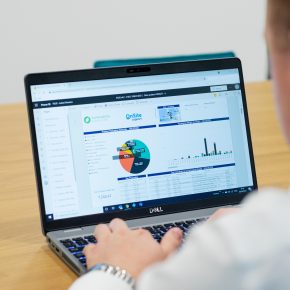
OnSite Support: Reduced emissions through optimised deliveries
With the need to reduce the environmental impact of construction, it is important to look at how carbon emissions can be reduced throughout the supply chain. Here, Warren Lynes, Managing Director at OnSite Support, looks at how optimising deliveries with a data driven approach can reduce carbon emissions as well as have a positive impact on efficiencies.
“For large main contractors or housebuilders, a significant part of the total carbon emissions impact of the business will come from the deliveries of materials to site.
The reality is that many will focus on the current day to day operational requirements, especially when it comes to procuring Personal Protective Equipment (PPE), Site Welfare, Equipment and Tools. This often means frequent small orders, generating a large cumulative carbon footprint.
An effective way to reduce CO2, as well as other emissions such as carbon monoxide, nitrous oxide and PM10 particles, is to analyse the purchase data and begin consolidating orders to reduce the total number of deliveries.

This is also a relatively simple way of reducing the carbon footprint of the business as it does not require a significant change in what materials are selected or the procurement route.
For example, we have significantly reduced clients’ Scope 3 CO2 emissions (indirect emissions from the supply chain), in some cases by more than 25%. In 2020, we helped to save approximately 600 metric tonnes of CO2 for our customers by helping them to optimise their orders and deliveries through this data driven approach.
However, effective analysis is crucial to this process as it is often difficult to see where the issues are and therefore how to address them. Providing suppliers track and record the required data accurately, they can work with contractors to analyse the purchasing behaviour for each site and identify where improvements can be made.
At OnSite Support, we have offered this through PLUS, which provides companies transparency of data enabling them to improve purchasing decisions as well as achieve commercial efficiencies through the meaningful business insights.
Among other metrics, a system such as PLUS provides information on the number of deliveries to each site, the cumulative total of miles driven to make these deliveries, and the carbon impact.
While other factors such as the size or location of the site must also be considered, this data allows poorly performing sites, such as those with disproportionally frequent orders, to be identified. It also allows a benchmark to be set for each site so progress can be tracked.
The next step is to work towards optimising the number of deliveries by combining orders together. This can be achieved in different ways through collaboration between the supplier and client.
This includes implementing prompts, both when ordering over the phone and online, suggesting that staff on site build up a larger basket of items before placing the order.
It can also be accomplished through an agreement of physical limits on the number of deliveries per week. As such, the team on site can place orders throughout the week but deliveries will only be made on the agreed schedule.
Of course, with PPE and other items that are required for safety, there should always be the option to have the items delivered as a priority.
This level of planning and optimisation of purchasing does require collaboration and cooperation throughout the business, as well as communication with those on site to explain the changes and the reasons behind it. The biggest improvements can be made where everyone involved is committed to the objectives and takes responsibility for achieving them.
A further benefit of having access to accurate and reliable data regarding CO2 emissions is that it allows much better reporting. While reporting on Scope 3 emissions are not a mandatory part of the Streamlined Energy and Carbon Reporting (SECR) introduced in 2019, it is a focus for many environmentally responsible businesses.
The use of the data for this purpose not only allows the CO2 emissions to be tracked and monitored, but also for the improvements and progress to be clearly demonstrated to all stakeholders.
Finally, despite the clear advantages of order analysis and optimisation for environmental performance, the value and benefits extend far beyond this.
For example, at OnSite Support, our PLUS reporting system encompasses four key areas – Purchasing, Logistics, Use and Sustainability. This allows us to save our customers money through reduced order processing costs, improve purchase efficiency and enhance safety and productivity as well as reducing environmental impact.
A demonstration of how this works in practice is our work with Morrisroe. We analysed the purchasing data for all Morrisroe sites and agreed a flexible protocol to consolidate deliveries that balanced efficiency with any urgent requirements.
Comparing the same three-month (March to May) period in 2019 and 2020, the number of orders made by Morrisroe fell by 3.6% despite spend increasing by 54%.
As a result, the order processing cost (OPC) was reduced from 26% to 16% of the total order value. Improvements have continued to be made, with the average value per order improving by 22% in Q1 2021 compared with the same three months in 2020.
Furthermore, the CO2 emissions generated also improved, with a 32% reduction in kilograms of carbon emissions produced when comparing January to March in 2020 and 2021.
With CO2 generation, it is important to remember that this is generated not just by the number of orders and deliveries but also by the location of sites – and the distances travelled.
For large construction businesses operating a number of sites, improving the efficiency of purchasing and delivery can have a significant impact on the levels of carbon emissions generated.
Working with a supplier who can provide the required analysis and implement measures to improve performance will ensure optimal supply and a reduced carbon footprint.”
To find out more about PLUS, visit www.onsite-support.co.uk/plus
Latest news

22nd November 2024
Pop Up Power Supplies Gets Arty in Yorkshire
Pop Up Power Supplies has installed 13 new electricity units at The Hepworth Wakefield – read more in this article…
Posted in Articles, Building Industry News, Building Products & Structures, Building Services, Case Studies, Civil Engineering, Facility Management & Building Services, Garden, Hard Landscaping & Walkways, Landscaping, Posts, Restoration & Refurbishment, Retrofit & Renovation
22nd November 2024
OPT Services Revolutionises Fibre Cable Capping with Eco-Friendly Innovation
UK-based OPT Services has unveiled SlimLine™ Capping, a groundbreaking fibre cable protection solution that promises to deliver significant environmental and installation advantages to the fibre optic industry.
Posted in Articles, Building Industry News, Building Products & Structures, Building Services, Facility Management & Building Services, Information Technology, Innovations & New Products, Sustainability & Energy Efficiency
22nd November 2024
CRL: The elegance of Paris balconies - a modern touch for any home
Paris balconies, with their timeless charm and practicality, are becoming something of an architectural staple in urban and rural environments, as CRL explains here…
Posted in Articles, Balustrades and Guardrails, Building Industry News, Building Products & Structures, Case Studies, Garden, Glass, Glass Projects, Restoration & Refurbishment, Retrofit & Renovation
21st November 2024
Altro distils style and performance at English Spirit
English Spirit Distillery has used an extensive package of Altro products front and back of house, in their new visitor centre café, shop and viewing area for the working distillery.
Posted in Articles, Bathrooms, Bedrooms & Washrooms, Building Industry News, Building Products & Structures, Building Systems, Case Studies, Floors, Interior Design & Construction, Interiors, Kitchens, Restoration & Refurbishment, Retrofit & Renovation, Timber Buildings and Timber Products, Walls
 Sign up:
Sign up: